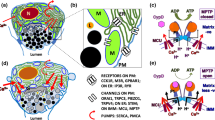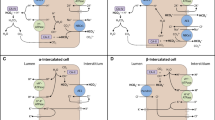Abstract
Data on conservative treatment in children with urolithiasis are limited. The aim of the study was to determine the metabolic etiology and results of conservative treatment in children with urolithiasis. We evaluated the clinical presentation and metabolic features of 112 children with urolithiasis. The mean age at diagnosis of urolithiasis was 3.9 (range 0.1–18) years, and follow-up duration was 16.7 (range 1–36) months. The most common presenting symptoms were flank or abdominal pain and restlessness (25%). Urine analysis revealed metabolic abnormalities in 92% of cases, including hypocitraturia (42%), hyperoxaluria (32.1%), hypercalcuria (25%), hyperuricosuria (9.8%), and cystinuria (2.7%). Patients who had metabolic risk factors were treated according to underlying metabolic abnormalities. About half of these patients were stone free or stones were diminished in size. These results showed that early recognition and treatment of urinary metabolic abnormalities will reduce the number of invasive procedures and renal damage in children with urolithiasis.
Similar content being viewed by others
References
Goldfarb DS (2003) Increasing prevalence of kidney stones in the United States. Kidney Int 63:1951–1952
VanDervoot K, Wiesen J, Frank R, Vento S, Crosby V, Chadra M, Trachtman H (2007) Urolithiasis in pediatric patients: a single center study of incidence, clinical presentation and outcome. J Urol 177:2300–2305
Remzi D, Çakmak F, Erkan I (1980) A study on urolithiasis incidence in school age children. J Urol 123:608–610
Sirin A, Emre S, Alpay H, Nayir A, Bilge I, Tanman F (1995) Etiology of chronic renal failure in Turkish children. Pediatr Nephrol 9:549–552
Turkey National Hemodialysis (2004) Transplantation and Nephrology Registry Report of Turkey 2003. Istanbul. Available at: https://doi.org/www.tsn.org.tr/registry/Registry_2003_Tr_Eng.pdf
Erbagci A, Erbagci AB, Yılmaz M, Yagci F, Trakcioglu M, Yurtseven C, Koyluoglu O, Sarica K (2003) Pedaitric urolithiasis evaluation of risk factors in 95 children. Scand J Urol Nephrol 37:129–133
Bak M, Ural R, Agin H, Serdaroglu E, Calkavur S (2009) The metabolic etiology of urolithiasis in Turkish children. Int Urol Nephrol 41:453–460
Cameron MA, Sakhaee K, Moe OW (2005) Nephrolithiasis in children. Pediatr Nephrol 20:1587–1592
Polito C, Cioce F, La Manna A, Maiello R, Di Torro R (1999) Renal calyceal microlithiasis: clinical presentation may precede sonographic evidence. Clin Pediatr (Phila) 38:521–524
Alon US (2009) Medical treatment of pediatric urolithiasis. Pediatr Nephrol 24:2129–2135
Alpay H, Ozen A, Gokce I, Biyikli N (2009) Clinical and metabolic features of urolithiasis and microlithiasis in children. Pediatr Nephrol 24:2203–2209
Ozkutan BH, Küçükaydın M, Gündüz Z, Kabaklioğlu M, Okur H, Turan C (2000) Urolithiasis in childhood. Pediatr Surg Int 16:60–63
Oner A, Demircin G, İpekcioğlu H, Bulbul M, Ecin N (1997) Etiological and clinical patterns of urolithiasis in Turkish children. Eur Urol 31:453–458
Perrone HC, Santos DR, Santos MV, Pinherio ME, Toporovski J, Ramos OL, Schor N (1992) Urolithiasis in childhood: metabolic evaluation. Pediatr Nephrol 6:54–56
Gerhart JP, Herzberg GZ, Jeffs RD (1991) Chilhood urolithiasis: experience and advances. Paediatrics 87:445–450
Hari P, Bagga A, Vasudev V, Singh M, Srivastava RN (1995) Aetiology of nephrolithiasis in north Indian children. Pediatr Nephrol 9:474–475
Dursun I, Poyrazoglu MH, Düşünsel R, Gündüz Z, Gürgöze MK, Demirci D, Küçükaydın M (2008) Pediatric urolithiasis: an 8-year experience of single center. Int Urol Nephrol 40:3–9
Hulton SA (2001) Evaluation of urinary tract calculi in children. Arch Dis Child 84:320–323
Tefekli A, Esen T, Ziylan O, Erol B, Armağan A, Ander H, Akıncı M (2000) Metabolic risk factors in pediatric and adult calcium oxalate urinary stone formers: is there any difference? Urol Int 459:1–10
Kalorin CM, Zabinski A, Okpareke I, White M, Kogan BA (2009) Pediatric urinary stones disease-does age matter? J Urol 181:2267–2271
Spivacow FR, Negri AL, del Valle EE, Calvino I, Zanchetta JR (2009) Clinical and metabolic risk factor evaluation in young adults with kidney stones. Int Urol Nephrol 42:471–475
Tekin A, Tekgül S, Atsu N, Bakkaloglu M, Kendi S (2002) Oral potassium citrate treatment for idiopathic hypocitraturia in children with calcium urolithiasis. J Urol 168:2572–2574
Sarica K (2006) Pediatric urolithiasis: etiology, specific pathogenesis and medical treatment. Urol Res 34:96–101
Author information
Authors and Affiliations
Corresponding author
Rights and permissions
About this article
Cite this article
Gürgöze, M.K., Sarı, M.Y. Results of medical treatment and metabolic risk factors in children with urolithiasis. Pediatr Nephrol 26, 933–937 (2011). https://doi.org/10.1007/s00467-011-1803-3
Received:
Revised:
Accepted:
Published:
Issue Date:
DOI: https://doi.org/10.1007/s00467-011-1803-3




